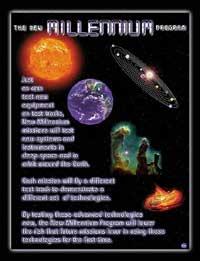Nanosat: the minisatelist of NASA's future
1999/10/24 Carton Virto, Eider - Elhuyar Zientzia
This is the latest NASA project: Launch of three minisatellites 40 cm long, 20 cm high and 10 kg of weight. The objective of the project is to analyze the usefulness of this type of probes for space research. To do this, the three new satellites will be placed in orbit in the magnetosphere. The magnetosphere is the furthest layer that surrounds the Earth, which extends between 600 and 90,000 km and is affected by the strong winds of the sun.

The winds of the sun are charged particles thrown from the star continuously as a result of the sun's own activity. This flow of particles is very harmful to the circuits and apparatus of satellites, as it can be perfectly rectified. In a first phase of the project, Americans want to see if mini-elites are able to withstand the influence of the solar wind. At the same time, it is considered that the information received will be useful for the Magnetospheric Constellation project, which will analyze the interaction between the magnetosphere and the winds of the sun.
The launch of three octagonal satellites is scheduled for 2003, within the Space Technology Five (ST5) project, valued at $28 million (about 4,000 million pesetas, about £160 million). The three satellites will revolve around the Earth forming a formation named Nanosat Constellation Trailblazer (NTC). Although the Earth environment is already full of telecommunication satellites, for the first time such constellations will arrive so far. In addition, these three satellites will circulate in separate orbits and the relative distance between them will be between 100 and 1,000 km. Using the GPS, the three probes will always know their position with respect to the other two. This would allow NASA experts to redefine and recompose the constellation in case of failure or loss of orbit in the worst case scenario.

NASA has thus resumed space exploration with the revamped New Milenium Program (NMP). One of the objectives of this renewal is to develop cheaper exploratory techniques than in recent years. The ST5 project is being developed for this purpose. The construction of mini-elites, in addition to being cheaper, would require space projectors of less power than until now, which would imply a greater reduction of costs.
Of course, micro and nanotechnologies must be developed to achieve this. Another goal of this new program is to get "smart" spacecraft. These spacecraft would not need a driver, and could conduct and repair their faults autonomously. In addition, fewer people would be needed to care for these probes. Finally, even if a range of satellites of this type is sent and one is lost, the task should not be suspended.
Each NMP project is in a way a "draft" of more sophisticated travel for the future. And while these new technologies are being tested, it is getting first-hand information about space. Years later, the first three satellites will become real space naval fleets. It's about sending more than 100 of them at once. A show.
Projects of the New Milenium Program
In addition to the aforementioned ST5 project, there are other ideas of interest within the NMP program:
Deep Space
1. This probe sent on October 24, 1998 aims to study the small bodies of the solar system. It is the first spacecraft with ionic propulsion and fully automatic navigation.
Deep Space 2 .
These two probes will be placed on the surface of Mars on December 3. The objectives of this project are three: to study the thermal properties of the subsoil of the planet, to check the possible presence of ice in the soil of Mars and to determine the atmospheric characteristics of the red planet.
Earth Observing 1.
In this project the Earth will be observed in the area of infrared and visible rays. The launch will take place on 15 December and if it works properly the new technology will be tested by the following Landsat series satellites.
Space Technology 3.
The technology of these three probes that will be launched in 2003 will allow observing both very distant stars and planetary systems as ours.
Published in 7

Gai honi buruzko eduki gehiago
Elhuyarrek garatutako teknologia





